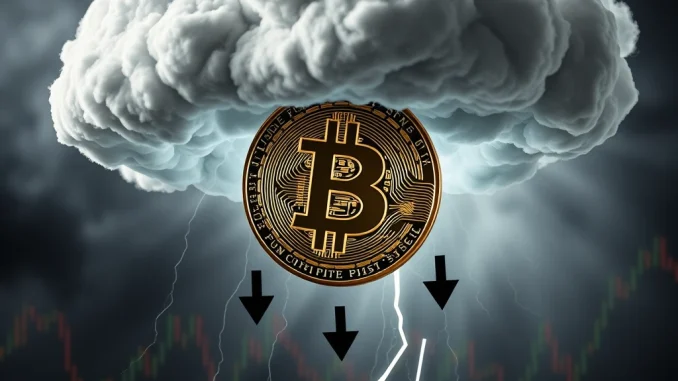
Is Bitcoin bracing for a storm? The cryptocurrency king is currently navigating a turbulent week, facing a confluence of negative factors that are casting shadows over its short-term price prospects. From looming U.S. tariffs to worrying technical indicators and a lackluster first quarter, the pressure is mounting on Bitcoin. Let’s dissect the key elements contributing to this market tension and explore what it could mean for your crypto portfolio.
Bitcoin’s Q1 Calamity: Why is This the Worst Start Since 2018?
The first quarter of 2024 has been far from celebratory for Bitcoin enthusiasts. Clocking in with a staggering 12% loss, this marks Bitcoin’s most dismal Q1 performance since the bear market of 2018. While the broader market has shown resilience in some sectors, Bitcoin has struggled to maintain its upward momentum.
Key Takeaways from Bitcoin’s Weak Q1:
- Double-Digit Decline: A 12% drop is a significant setback, especially considering the bullish sentiment that permeated the crypto space at the end of 2023.
- Underperforming Against Gold: Traditionally seen as a safe haven asset, gold has outperformed Bitcoin this quarter. This suggests investors are currently favoring traditional safe havens amidst economic uncertainties, potentially viewing Bitcoin with increased risk aversion.
- Broader Market Context: While some altcoins have shown pockets of strength, the overall crypto market sentiment has been cautious, contributing to Bitcoin’s struggle.
Why is this happening? Several macroeconomic factors, coupled with internal crypto market dynamics, are likely at play. Concerns about inflation, rising interest rates, and geopolitical instability are pushing investors towards less volatile assets. Furthermore, profit-taking after Bitcoin’s significant rally in late 2023 and early 2024 could also be contributing to the downward pressure. This Q1 performance serves as a stark reminder of Bitcoin’s inherent volatility and its sensitivity to broader economic trends.
Liberation Day or Economic Lockdown? The Terrifying Impact of US Tariffs on Bitcoin
April 2nd is looming large on the horizon for financial markets, and it’s not being celebrated as “Liberation Day” by everyone. This date marks the implementation of new U.S. trade tariffs, a move that could send ripples of uncertainty across global economies and, consequently, impact risk assets like Bitcoin.
Understanding the Tariff Threat to Bitcoin:
- Risk-Off Sentiment: Tariffs often lead to trade disputes and economic uncertainty. This, in turn, typically triggers a “risk-off” sentiment in markets, causing investors to move away from volatile assets like cryptocurrencies and towards safer havens.
- Potential Market Downturn: If the tariffs escalate trade tensions or negatively impact corporate earnings, we could see a broader market downturn. Bitcoin, despite its growing maturity, is still correlated to traditional markets to some extent, making it vulnerable to such downturns.
- Dollar Strength: Tariffs can sometimes lead to a stronger U.S. dollar. Historically, a stronger dollar has often had an inverse relationship with Bitcoin’s price, as Bitcoin is frequently priced against the dollar.
The fear is that these tariffs will act as a catalyst for a further Bitcoin price correction, potentially pushing it below the psychologically important $60,000 level, a level that many analysts are closely watching. While the long-term implications of these tariffs are still unfolding, their immediate impact on market sentiment is undeniably bearish.
Decoding Bearish Charts: Are Technical Indicators Flashing Red for Bitcoin?
Beyond macroeconomic headwinds, Bitcoin’s price charts are painting a somewhat grim picture from a technical analysis perspective. Several bearish charts patterns have emerged recently, suggesting that the downward pressure might persist in the short term.
Key Bearish Technical Signals:
- Bearish Engulfing Candle: This candlestick pattern, observed on recent daily charts, indicates a potential shift in momentum from bullish to bearish. It occurs when a red (downward) candle completely “engulfs” the previous green (upward) candle, signaling strong selling pressure.
- Death Cross Looming: While not yet fully formed, the 50-day moving average is trending downwards towards the 200-day moving average. A “death cross,” where the 50-day MA crosses below the 200-day MA, is a classic bearish indicator that can signal a prolonged downtrend.
- Weak Price Action Despite Mild Losses: Despite the relatively modest losses in March, the underlying price action has been weak. Rallies have been short-lived and lacked conviction, suggesting a lack of strong buying interest.
It’s crucial to remember that technical analysis is not foolproof. However, these bearish charts patterns, combined with the fundamental factors, warrant caution. Traders and investors are closely monitoring these indicators to gauge the potential for further downside and identify potential entry or exit points.
US Fed and Jobs Data: Will Macroeconomic Events Unleash Further Bitcoin Volatility?
This week is packed with crucial macroeconomic data releases from the U.S., which could act as further catalysts for market volatility, including Bitcoin. The focus is squarely on US Fed policy and the health of the U.S. labor market.
Upcoming Macroeconomic Events to Watch:
- U.S. Employment Data: Major employment data releases, including jobless claims and non-farm payrolls, are scheduled this week. Strong jobs data could reinforce the Fed’s hawkish stance on interest rates, potentially putting downward pressure on risk assets. Conversely, weaker-than-expected data could raise concerns about economic slowdown.
- Jerome Powell’s Speech: A speech by US Fed Chair Jerome Powell is also on the calendar. His comments will be closely scrutinized for any hints about the future direction of monetary policy. Any hawkish signals could further dampen market sentiment.
- Inflation Expectations: Beyond jobs data, inflation expectations will remain a key driver. If inflation shows signs of re-accelerating, it could prompt the Fed to maintain or even increase its hawkish stance, negatively impacting Bitcoin and other risk assets.
These macroeconomic events have the potential to inject significant volatility into the market. Traders should be prepared for potential price swings and adjust their strategies accordingly. The interplay between US Fed policy and economic data will be crucial in shaping Bitcoin’s price trajectory in the coming days and weeks.
Investor Sentiment Check: Is Cautious Optimism Still Alive for Bitcoin?
Amidst the bearish signals and market pressures, it’s essential to gauge investor sentiment to understand the underlying market psychology. While fear and uncertainty are undoubtedly present, there are also glimmers of cautious optimism, suggesting that a complete capitulation might not be imminent.
Insights into Investor Sentiment:
- Easing Panic Selling: While selling pressure exists, outright panic selling seems to be easing. This suggests that many long-term holders are remaining steadfast, despite the short-term price weakness.
- Neutral Coinbase Premium: The Coinbase Premium, which measures the price difference between Coinbase and other exchanges, is currently holding neutral. A neutral premium suggests that buying and selling pressure on Coinbase, a proxy for U.S. institutional and retail investor sentiment, is balanced. This indicates a degree of cautious optimism rather than outright fear.
- Long-Term Belief Remains: Despite the current headwinds, the fundamental long-term bullish narrative for Bitcoin – driven by factors like scarcity, decentralization, and growing institutional adoption – remains intact. Many investors continue to view the current dip as a potential buying opportunity for the long haul.
While short-term investor sentiment is undoubtedly cautious, the absence of widespread panic and the neutral Coinbase Premium suggest that a segment of the market is still holding onto a degree of optimism. This underlying belief in Bitcoin’s long-term potential could provide a floor for prices and potentially pave the way for a future recovery, once the current headwinds subside.
Bitcoin’s Crossroads: Navigating the Current Storm
Bitcoin is undeniably facing a challenging period. The combination of U.S. tariffs, bearish technical indicators, and a weak Q1 performance has created a perfect storm of negative pressures. The upcoming macroeconomic data and Fed commentary will further shape the short-term outlook. While caution is warranted, it’s also important to remember that the crypto market is inherently volatile and prone to cycles. Long-term investors may view this period as an opportunity to accumulate Bitcoin at lower prices, while short-term traders should remain nimble and prepared for potential price swings. The coming weeks will be crucial in determining whether Bitcoin can weather this storm and regain its upward trajectory, or if further downside is in store.



